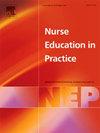加强卫生保健教育:对可委托的专业活动进行有效评估的中国传统平等准则的验证
IF 3.3
3区 医学
Q1 NURSING
引用次数: 0
摘要
目的本研究旨在评估医疗保健教育中可信赖的专业活动(EPAs)质量的重要评估工具——中文版EQual量表的信度和效度。医疗保健专业的教育模式越来越强调能力为本的教育(CBE),需要标准化的评估工具。环境评估方案为这种方法提供了一个框架,突出了对强有力的评估工具的需要。设计:本研究采用定量方法,在为临床研究护士(crn)和肿瘤学护士(on)制定EPA计划的背景下,翻译并验证了传统的中国平等准则。4名高级crn和4名on担任评级员。方法研究分三个阶段进行:首先,采用标准化流程将《平等》标题从英文翻译成繁体中文,然后由两名双语专家进行反译。一次协商一致的会议最终确定了翻译。其次,内容验证涉及三位专家评估规则的清晰度和适用性。最后,用8个评价者评价了EQual准则的内部一致性信度。结果传统汉语平等量表具有较强的内容效度和可接受的量表间信度,具有较高的量表水平内容效度指数,表明专家认同度较高,证实了其在教育环境中的适用性。结论繁体中文平等量表的成功翻译和验证,使其成为一种可靠的评价卫生保健教育环境教育质量的评估工具,对文化教育做出了重要贡献,并强调了文化相关评估工具的重要性。本文章由计算机程序翻译,如有差异,请以英文原文为准。
Enhancing healthcare education: Validation of the traditional chinese EQual rubric for effective assessment of entrustable professional activities
Aim
This study evaluates the reliability and validity of the Traditional Chinese version of the EQual rubric, a vital tool for assessing the quality of Entrustable Professional Activities (EPAs) in healthcare education.
Background
The healthcare professional’s educational model increasingly emphasizes competency-based education (CBE), necessitating standardized evaluation tools. EPAs provide a framework for this approach, highlighting the need for robust assessment instruments.
Design
Utilizing a quantitative methodology, this study translated and validated the Traditional Chinese EQual rubric in the context of developing EPA programs for clinical research nurses (CRNs) and oncology nurses (ONs). Four senior CRNs and four ONs served as raters.
Methods
The research was conducted in three phases: First, the EQual rubric was translated from English to Traditional Chinese using a standardized process, followed by back-translation by two bilingual experts. A consensus meeting finalized the translation. Second, content validation involved three experts assessing the rubric’s clarity and applicability. Finally, the internal consistency reliability of the EQual rubric was evaluated with eight raters.
Results
The Traditional Chinese EQual rubric demonstrated strong content validity and acceptable inter-rater reliability, with a high scale-level content validity index indicating robust expert agreement, affirming its applicability in educational settings.
Conclusions
The successful translation and validation of the EQual rubric in Traditional Chinese establish it as a reliable assessment tool for evaluating the quality of EPAs in healthcare education, significantly contributing to CBE and underscoring the importance of culturally relevant evaluation instruments.
求助全文
通过发布文献求助,成功后即可免费获取论文全文。
去求助
来源期刊

Nurse Education in Practice
NURSING-
CiteScore
5.40
自引率
9.40%
发文量
180
审稿时长
51 days
期刊介绍:
Nurse Education in Practice enables lecturers and practitioners to both share and disseminate evidence that demonstrates the actual practice of education as it is experienced in the realities of their respective work environments. It is supportive of new authors and will be at the forefront in publishing individual and collaborative papers that demonstrate the link between education and practice.
 求助内容:
求助内容: 应助结果提醒方式:
应助结果提醒方式:


